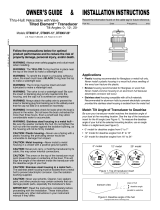
17-620-01 rev. 03 07/24/18
In-Hull: 1-1.5kW, Adjustable-angle
Depth Transducer
Wideband Model: M422
Chirp Models: M135M, M285HW
Patent http://www.airmar.com/patent.html
Applications
• For fiberglass hulls only
• Recommended for high-speed powerboats and racing sailboats
• Accommodates a deadrise angle from 0° to 22°
Tools & Materials
Safety glasses
Dust mask
Ear protection
Adhesive tape
Pole
Detergent (some installations)
Weak solvent (such as alcohol)
Disk sander (some installations)
Thin sealable plastic bag (some installations)
Cable ties (some installations)
Water-based lubricant (such as K-Y® jelly) (some installations)
Angle finder
Carpenter’s square
Pencil
Bonding material (see www.airmar.com for additional brands):
Fiberglass resin: Bondo 401
West Marine #1937762)
or Marine-Tex epoxy putty (14 oz. pack)
or 3M™ Marine Adhesive/Sealant 5200
Propylene glycol (non-toxic antifreeze/coolant) 0.4 liter (14 fl. oz.)
Petroleum jelly
Torque-limiting screwdriver
Level
Grommet(s) (some installations)
Installation in a cored fiberglass hull (page 4):
Cutting tool 20cm or 8" hole
Miniature disk sander
Casting epoxy (Polypoxy #7035/7040) or resin
Paper cup
Stirrer
Mounting Location
About Fiberglass Hulls
The fiberglass hull below the transducer must be solid. Since the
hull absorbs acoustic energy, transmitting through the hull
reduces the transducer’s performance. Fiberglass hulls are often
reinforced in places for added strength or to reduce weight. These
cored areas contain balsa wood or structural foam which are poor
sound conductors. Do not locate the transducer over coring.
Choose a Location
• Where the fiberglass is SOLID (no air bubbles are trapped in
the fiberglass resin) and where no coring, flotation material, or
dead air space is sandwiched between the inside skin and outer
skin of the hull.
• Where the hull below the transducer will be in contact with the
water at all times.
• Where the water flowing under the hull is smoothest with a min-
imum of bubbles and turbulence (especially at high speeds). Do
not mount the transducer in line with or near water intake or dis-
charge openings; or behind strakes, fittings, or hull irregularities
that will disturb the water flow.
• Where the transducer beam will not be blocked by the keel or
propeller shaft(s).
• Away from interference caused by power and radiation sources
such as: the propeller(s) and shaft(s), other machinery, other
echosounders, and other cables. The lower the noise level, the
higher the echosounder gain setting that can be used.
• Where the deadrise angle of the hull does not exceed 22°.
• Where there is space inside the vessel for the size of the base
and installing the transducer.
• Chirp transducer—Mount in a cool well-ventilated area away
from the engine to avoid overheating the liquid inside the base.
Record the information found on the cable tag for future reference.
Part No._________________Date___________Frequency________kHz
Follow the precautions below for optimal
product performance and to reduce the risk of
property damage, personal injury, and/or death.
WARNING: Always wear safety glasses, a dust mask,
and ear protection when installing.
CAUTION: Chirp transducer—Always operate the
transducer in liquid. Operating in air will allow the
transducer to overheat resulting in failure.
CAUTION: The fiberglass hull below the transducer
must be SOLID. The transducer will not transmit
through coring material such as foam or balsa wood.
CAUTION: Chirp transducer—Do not install in the
engine compartment or other hot place. The
transducer may fail if the temperature of the liquid in
the base exceeds 60° C (140° F).
CAUTION: Never pull, carry, or hold the transducer by
the cable. This may sever internal connections.
CAUTION: Do not use an epoxy adhesive because it
is too brittle.
CAUTION: Never use solvents. Cleaner, fuel, sealant,
paint, and other products may contain solvents that can
damage plastic parts, especially the transducer’s face.
IMPORTANT: Please read the instructions completely
before proceeding with the installation. These
instructions supersede any other instructions in the
instrument manual if they differ.
OWNER’ S GUIDE & INSTALLATION INSTRUCTIONS




